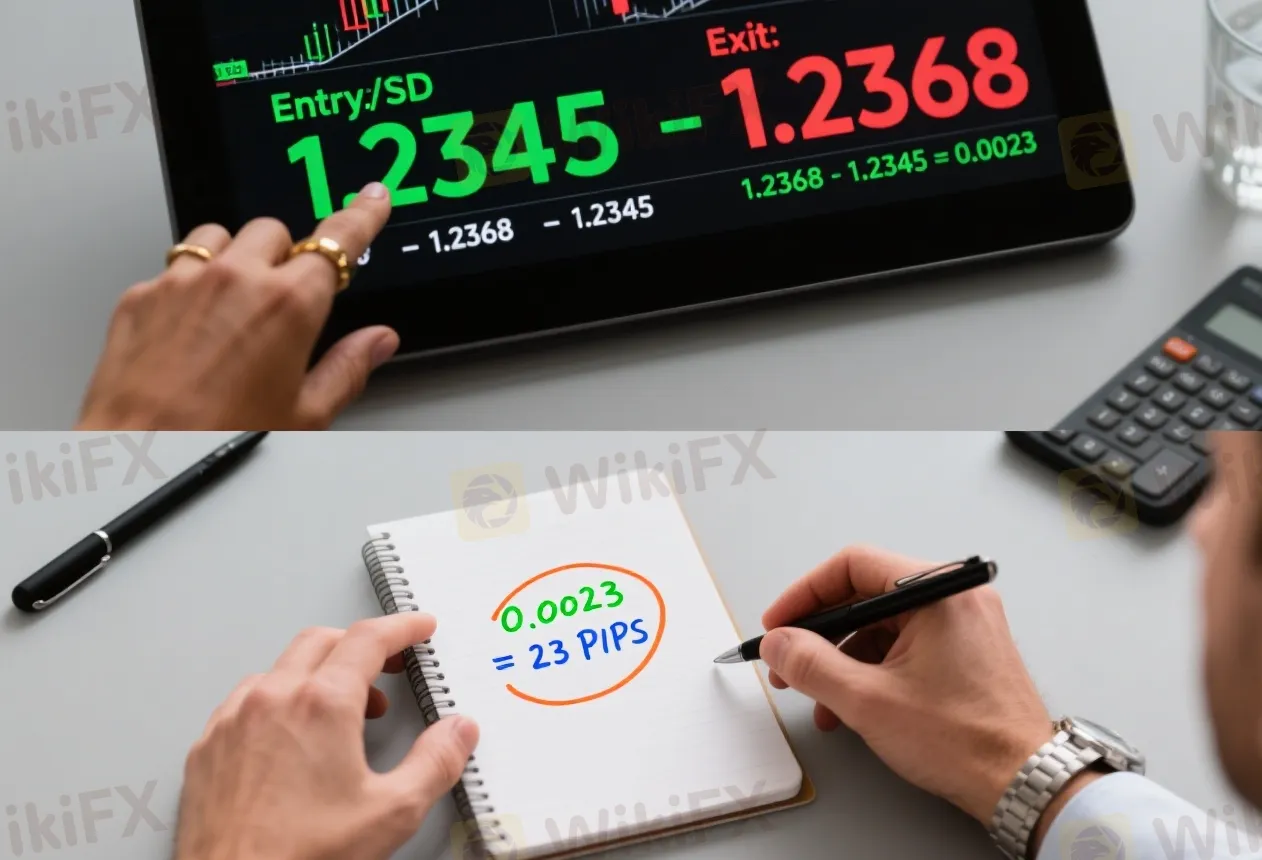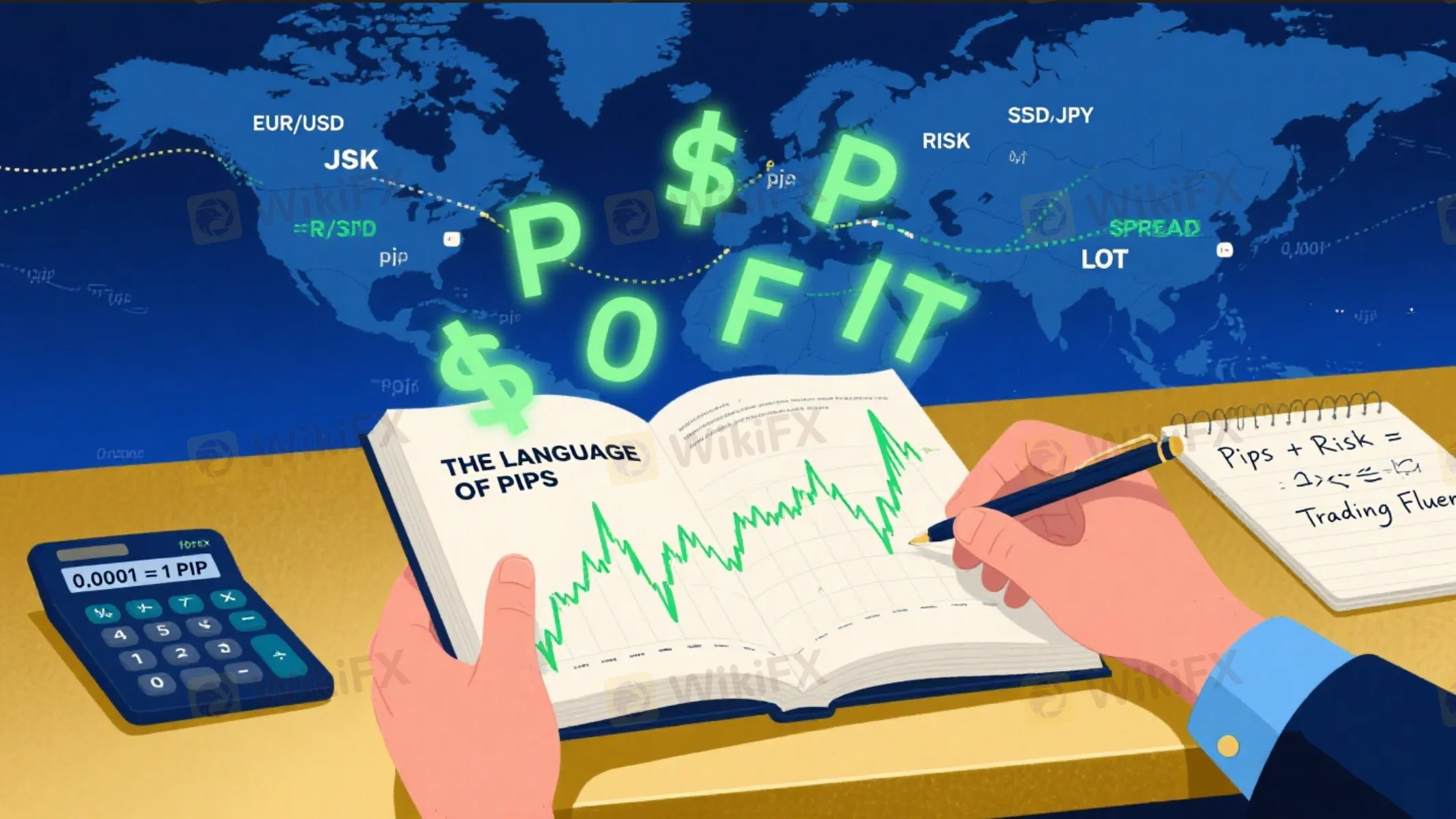The Ultimate Guide: How to Count and Calculate Pips in Forex
Abstract:Mastering how to count and calculate pips in forex is a rite of passage for every serious trader. It transforms abstract price charts into a concrete language of profit, loss, and risk. We've learned that a pip is the standard unit of price change. But its monetary value is dynamic, depending on the pair, trade size, and your account currency. We've also seen that to find your true profit, you must account for costs like the spread. Even when you use calculators and platform tools for speed, knowing how to calculate pips manually gives you deep, intuitive understanding of your trade mechanics. This skill isn't optional. It's the foundation upon which sound risk management and consistent strategy execution are built. By mastering it, you've taken a major step toward becoming a more competent and confident trader.
Have you ever closed a forex trade feeling confused about your exact profit or loss? You see the price moved. But connecting that movement to a dollar amount feels like solving a puzzle. New traders experience this all the time.
The answer lies in understanding the “pip.” A pip is the smallest standardized unit that measures value changes between two currencies.
Learning how to count pips in forex goes beyond technical knowledge. It forms the foundation of professional trading. This skill lets you measure performance accurately. You can manage risk with precision. You can develop strategies that work.
This guide walks you through the complete process. We'll cover these key areas:
- What a pip is and why it matters
- How to count pips directly on trading charts
- Calculating the exact dollar value of each pip
- Using this knowledge in real trading situations
What is a Pip?
A pip is the fundamental building block of your trades. The term stands for “Percentage in Point” or “Price Interest Point.” It represents a tiny measure of change in a currency pair.

Think of it like cents to a dollar. Or inches to a mile. It's the standardized unit that allows traders worldwide to communicate price movements clearly. The value a pip represents depends on the currency pair you're trading. For most pairs, a pip is a movement in the fourth decimal place. For pairs involving the Japanese Yen (JPY), it's a movement in the second decimal place. Here's an example. If EUR/USD moves from 1.0735 to 1.0736, that's a one-pip move. If USD/JPY moves from 157.45 to 157.46, that's also a one-pip move.
You'll also encounter a “pipette” or fractional pip. This is the fifth decimal place for most pairs and the third for JPY pairs. Brokers use pipettes for more precise pricing. But the pip remains the standard for all calculations.
Here's a clear breakdown:
| Pair Type | Example Price | The “Pip” Digit | The “Pipette” Digit |
| Non-JPY Pair | EUR/USD: 1.07359 | 5 | 9 |
| JPY Pair | USD/JPY: 157.452 | 5 | 2 |
The Core Skill
Now we move to practical application. This directly answers how to count pips in forex. The skill involves simple subtraction to find the difference between your entry and exit prices.
Counting in a Long Trade
Let's start with a buy or “long” trade. In this scenario, you profit when the price moves up.
Imagine you buy the EUR/USD pair at 1.0810. Later, the price rises. You close your trade at 1.0860.
To find the pip difference, subtract the entry price from the exit price.
`1.0860 (Exit Price) - 1.0810 (Entry Price) = 0.0050`
The pip is the fourth decimal place. This difference of 0.0050 represents a 50-pip gain.
Counting in a Short Trade
Now let's calculate pips for a sell or “short” trade. Here, you profit when the price goes down.
Suppose you sell the GBP/JPY pair at 198.80. The price then falls. You close the trade at 198.20.
To find the pip difference, subtract the exit price from the entry price.
`198.80 (Entry Price) - 198.20 (Exit Price) = 0.60`
The pip for JPY pairs is the second decimal place. This difference of 0.60 represents a 60-pip gain.
New traders often get confused about subtraction order. Here's an easy rule: always subtract the smaller number from the larger one to find the absolute pip difference. The crucial next step is knowing whether that difference is a profit or loss. Did the price move in your favor or against you?
The Critical Next Step
Knowing you made 50 pips is one thing. Knowing how much money that represents is the real goal. This is where you learn to calculate forex pip value.
A pip's monetary value isn't fixed. It changes based on three critical factors:
1. The currency pair being traded
2. The size of your trade (your lot size)
3. Your account currency (USD, EUR, GBP, etc.)
The universal formula to calculate a pip's value is:
`Pip Value = (One Pip / Exchange Rate) * Lot Size`
Let's break down each component. “One Pip” is the decimal representation (0.0001 for most pairs, 0.01 for JPY pairs). The “Exchange Rate” is the current price of the pair. “Lot Size” is the number of currency units you're trading.
The calculation method changes slightly. It depends on the relationship between the pair you're trading and your account currency.
Case 1: USD Account, XXX/USD Pair
This is the most straightforward scenario. You have a USD account and trade a pair where USD is the second currency (the “quote” currency). The pip values are fixed and easy to remember.
This applies to pairs like EUR/USD, GBP/USD, and AUD/USD.
Here are the standard values:
| Lot Size | Units | Pip Value (for XXX/USD pair on USD account) |
| Standard Lot | 100,000 | $10 |
| Mini Lot | 10,000 | $1 |
| Micro Lot | 1,000 | $0.10 |
For every one-pip move on a standard lot of EUR/USD, your profit or loss changes by $10. For a mini lot, it's $1. For a micro lot, it's $0.10.
Case 2: USD Account, USD/XXX Pair
Things change when your account currency is the base currency (the first currency in the pair). Let's calculate a pip for a pair like USD/CAD with a USD account.
Here, you must use the formula. Assume the current USD/CAD exchange rate is 1.3700. You're trading one standard lot (100,000 units).
1. One Pip: 0.0001
2. Lot Size: 100,000 units of USD
3. Exchange Rate: 1.3700 (USD/CAD)
`Pip Value = (0.0001 / 1.3700) * 100,000`
`Pip Value = 0.00007299 * 100,000`
`Pip Value = $7.30`
One pip of movement is worth approximately $7.30, not the fixed $10 from our first example.
Case 3: USD Account, Foreign Cross Pair
The most complex scenario occurs when your account currency isn't part of the traded pair. For example, trading EUR/GBP with a USD account. This requires a two-step calculation.
First, calculate the pip value in the quote currency (GBP). Then convert that value back to your account currency (USD).
Assume the EUR/GBP exchange rate is 0.8500. You're trading one standard lot (100,000 units).
Step 1: Calculate Pip Value in the Quote Currency (GBP)
`Pip Value (in GBP) = (0.0001 / 0.8500) * 100,000`
`Pip Value (in GBP) = £11.76`
One pip is worth 11.76 British Pounds.
Step 2: Convert to Account Currency (USD)
Now convert this GBP value to USD. You need the current GBP/USD exchange rate. Assume it's 1.2500.
`Pip Value (in USD) = Pip Value (in GBP) * GBP/USD Exchange Rate`
`Pip Value (in USD) = 11.76 * 1.2500`
`Pip Value (in USD) = $14.70`
For this trade, one pip is worth $14.70. The key is always determining the initial pip value in the quote currency of the pair you're trading.
From Theory to Practice
Let's solidify this knowledge with detailed, real-world trading examples. This is where you connect the concepts and truly learn how to calculate pips in forex from start to finish. We'll use a consistent structure for each case: the setup, the calculation, and the outcome.
Case Study 1: Long EUR/USD
This is a classic trade on a major pair. It represents the most common scenario for many traders.
- Trade Setup: You decide to buy 1 Mini Lot (10,000 units) of EUR/USD. Your entry price is 1.0725. You set a stop loss at 1.0700 and a take profit at 1.0785. Your account is denominated in USD.
- The Calculation:
1. First, calculate the pips at risk. The distance from your entry (1.0725) to your stop loss (1.0700) is 0.0025, or 25 pips.
2. Next, calculate the pips targeted for profit. The distance from your entry (1.0725) to your take profit (1.0785) is 0.0060, or 60 pips.
3. Determine the pip value. You have a USD account and are trading EUR/USD with a mini lot. The pip value is a fixed $1 per pip.
4. Calculate the potential loss: 25 pips * $1/pip = $25.
5. Calculate the potential profit: 60 pips * $1/pip = $60.
- The Outcome: The market rallies and your trade hits the take profit target at 1.0785. Your total profit for the trade is 60 pips, which equals $60.
Case Study 2: Short GBP/JPY
Trading JPY pairs requires careful attention to pip value calculation. It's a common area where new traders make mistakes.
- Trade Setup: You decide to sell 1 Standard Lot (100,000 units) of GBP/JPY. Your entry price is 198.50. The price falls. You decide to close the trade manually at 197.90. Your account is in USD.
- The Calculation:
1. First, calculate the pips gained. Subtract the exit price from the entry price: 198.50 - 197.90 = 0.60. This is a 60-pip gain.
2. Next, calculate the pip value. Your account is in USD, so you need to use the formula and convert from JPY.
3. You need the current USD/JPY exchange rate for the final conversion. Assume USD/JPY is trading at 157.00.
4. The formula for the pip value of a standard lot of a JPY pair is: `Pip Value = (0.01 / USD/JPY Rate) * 100,000`.
5. `Pip Value = (0.01 / 157.00) * 100,000`
6. `Pip Value = 0.00006369 * 100,000 = $6.37` per pip.
7. Finally, calculate the total profit in USD: 60 pips * $6.37/pip = $382.20.
- The Outcome: By closing the trade, you secured a profit of 60 pips. This translates to $382.20 in your USD account.
Case Study 3: Navigating an Exotic Pair
Exotic pairs like USD/ZAR (South African Rand) often have much larger price movements and different pip value dynamics.
- Trade Setup: You buy 2 Mini Lots (20,000 units) of USD/ZAR at 18.5500. The price moves in your favor. You close the trade at 18.7500. Your account is in USD.
- The Calculation:
1. First, calculate the pips gained: 18.7500 - 18.5500 = 0.2000. Notice the price scale; this is a 2000-pip gain.
2. Next, calculate the pip value. The base currency (USD) matches your account currency, so you must use the formula.
3. The formula is `Pip Value = (One Pip / Exchange Rate) * Lot Size`. You're trading 2 mini lots, so your lot size is 20,000.
4. `Pip Value = (0.0001 / 18.7500) * 20,000` (Use the exit rate for the most accurate calculation).
5. `Pip Value = 0.00000533 * 20,000 = $0.1066`.
6. This value is for the entire position. To find the per-pip value for one mini lot (10,000 units), it would be approximately $0.053. This is much lower than a major pair.
7. Now calculate the total profit: 2000 pips * $0.0533/pip (per mini lot) * 2 mini lots = $213.20.
- The Outcome: The 2000-pip move resulted in a profit of $213.20. This highlights how exotics have large pip movements but a much lower value per pip.
Beyond Pips
A critical insight for developing traders is this: the number of pips you gain isn't your final profit. To get a true picture of your performance, you must account for trading costs. This is how to calculate forex pips in a way that reflects your actual account balance.

Don't Forget the Spread
The most fundamental cost of trading is the spread. The spread is the difference between the bid price (the price at which you can sell) and the ask price (the price at which you can buy).
If a chart shows EUR/USD at 1.0850, that's likely the mid-price. In reality, you might see a bid price of 1.0849 and an ask price of 1.0851. This 2-pip difference is the broker's spread.
When you enter a trade, you immediately incur the cost of the spread. Your trade must first move enough pips in your favor to cover this cost before it becomes profitable.
The Full P&L Equation
To calculate your true net profit or loss, subtract the spread from your gross pip gain. This gives you a more realistic and professional view of your trading results.
The comprehensive formula looks like this:
`Net Profit/Loss = (Pip Difference - Spread in Pips) * Pip Value`
Here's a quick example. You go long on GBP/USD and make a 30-pip gain from your entry to your exit. The spread on the pair was 3 pips. The pip value for your trade size is $1.
Your gross profit is 30 pips. But your net profit is `(30 pips - 3 pips) * $1/pip = $27`.
Being transparent about trading costs is essential for accurate record-keeping and strategy evaluation. It builds immense trust in your own process. This detail is often glossed over in simpler guides.
Effortless Calculation Tools
Understanding the manual calculation is vital for building foundational knowledge. But in live trading, efficiency and accuracy are paramount. Fortunately, several tools can make pip calculation effortless.
Online Pip Calculators
Numerous websites offer free forex pip calculators. These tools automate the entire process we've discussed.
You simply input the currency pair, your trade size in lots, and your account currency. The calculator instantly provides the value of one pip. This saves you time and prevents manual errors.
Platform Built-in Features
The most efficient method is using your trading platform's own tools. They're integrated directly into your workflow. For example, platforms like MetaTrader 4 and MetaTrader 5 have a “Crosshair” tool. You can click on your entry price on the chart and drag the cursor to your exit price or stop loss level. The platform will instantly display the distance in pips (or points), the price difference, and the number of bars. This is the fastest way to measure potential risk and reward on the fly.
Conclusion: Pips are Your Language
Mastering how to count and calculate pips in forex is a rite of passage for every serious trader. It transforms abstract price charts into a concrete language of profit, loss, and risk.
We've learned that a pip is the standard unit of price change. But its monetary value is dynamic, depending on the pair, trade size, and your account currency. We've also seen that to find your true profit, you must account for costs like the spread. Even when you use calculators and platform tools for speed, knowing how to calculate pips manually gives you deep, intuitive understanding of your trade mechanics.
This skill isn't optional. It's the foundation upon which sound risk management and consistent strategy execution are built. By mastering it, you've taken a major step toward becoming a more competent and confident trader.

Read more

Stockity Loses Traders’ Favor: Deposit Loss, Login & Withdrawal Issues
Are your profits through the Stockity platform vanishing suspiciously? Does the forex broker allow you to withdraw only your initial deposit? Do you face illegitimate login issues on Stockity? Have you witnessed unexplained fund losses while trading binary options on Stockity? Traders report these unfavorable experiences on online review platforms. These experiences indicate a potential scam from this Marshall Islands-based forex broker. In this article, we have highlighted trader reviews of Stockity. Keep reading!

Trusted Forex Broker Reviews Search Tool
Discover the most trusted forex broker reviews and ratings. Use the WikiFX app to compare and find top brokers safely and confidently.

SC Urges Malaysians To Stay Alert As Scam Complaints Double Since 2020
Malaysia’s Securities Commission warns that complaints about unlicensed investment activities have doubled in five years—3,602 cases in 2024 and 2,039 in H1 2025—highlighting increasingly sophisticated scams targeting even professionals and seniors. Schemes often mimic legitimacy, then block withdrawals via “compliance” or “maintenance” excuses. The core defense is pre-investment verification and ongoing risk control.

Top Tips to Avoid Forex Margin Calls and Protect Your Capital
While technical indicators or chart patterns often capture the attention of forex traders, especially new ones, aspects such as margin requirements, equity, used margin, free margin, and margin levels are often overlooked. So, if you have received a margin call from your forex broker and are wondering how to deal with it, you probably do not know the concept of a forex margin call - what triggers it and how to avoid it. Being unaware of this concept can make you lose your hard-earned capital. In this article, we will provide you with all the information you need to know. Keep reading!
WikiFX Broker
Latest News
UAE Launches Sixth 'Caution' Campaign to Combat Forex and Online Investment Fraud
US and UK Sanction Cambodia-Based Prince Group Over $16B Scam
David Stockman On How The Fed's Money Printing Broke American Industry... And What Comes Next
One Wrong Move Wiped Out a Government Retiree’s Lifetime Savings
Forex24 Faces CySEC Fine for Late Compliance Filing
OctaFX Forex Brokerage $318 million Fraud Case in India: Authorities Arrest Pavel Prozorov!
How Filipinos Can Recover Funds from Crypto Scams Abroad
Top Tips to Avoid Forex Margin Calls and Protect Your Capital
FCA Daily Alert: Checkout FCA Consumer Warning List
How to Protect Your Account Security? Three Methods to Reduce Phishing Risks
Rate Calc

